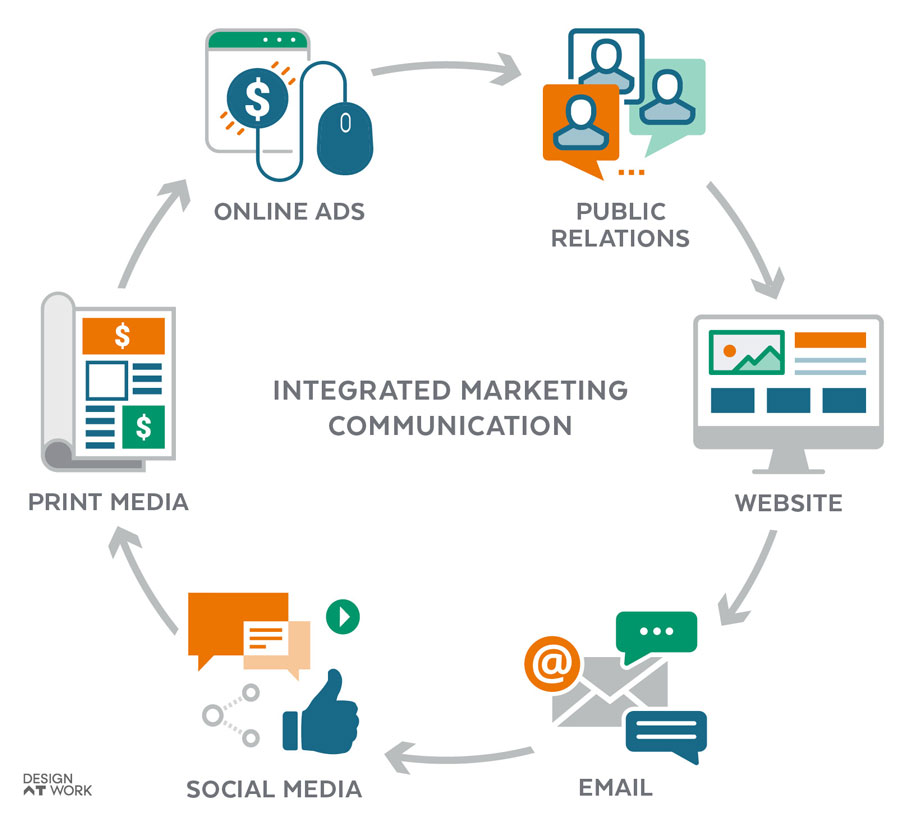MarCom and Integrated Marketing Form Distinct Parts of the Marketing Whole.

More than the products you sell, your company has a heartbeat — a “why” behind everything you do. While you might send dozens of marketing messages a day, how many of them are connected to that heartbeat?
Let’s say you’re a sports outfitter looking to advertise a new pair of athletic shoes. You could send a marketing email about the shoes, gaining a significant number of sales. However, if you want those sales to turn into loyal customers who are engaged with your brand, you may need to think bigger than email.
By merging all of your marketing communication efforts — email, social media, print advertising, PR and digital advertising — into one unified marketing plan and brand message, your audience will experience the whole picture of your sports brand while purchasing those new shoes. This strategy is known as integrated marketing communication.
Marketing Communication VS. Integrated Marketing Communication.

Marketing Communication (MarCom) refers to the methods and tools used to convey messages to segmented audiences. These messages are often tailored to specific products and services and use individual marketing tools and channels to communicate. MarCom can look like anything from TV advertising and print media to email marketing and social media campaigns.
Integrated Marketing Communication (IMC) is a strategy that takes things a step further to unify all parts of a company’s marketing efforts and create a cohesive brand message. IMC shares brand messages with a larger audience through several marketing channels and tools on a consistent basis. More than making sales, the goal of IMC is to generate brand awareness and build long-term relationships with audiences.
Here are some of the main differences between these two strategies:
Goals.
While MarCom aims to promote a specific product or service, the goal of IMC is to increase brand awareness through consistent messaging across all marketing platforms.
Strategies.
MarCom focuses on individual, segmented marketing strategies to promote a specific product or service to an isolated group. IMC unifies all marketing channels and tools to communicate a cohesive message that reaches a broader audience and points to the brand as a whole.
Channels.
While MarCom uses specific channels based on the product, service or audience type — an integrated marketing approach combines multiple channels like social media, email, digital ads, print media and more to communicate a synergized message.
Messaging.
MarCom sends varied marketing messages that are different based on the campaign’s goals. IMC places a high priority on sending consistent, evergreen messaging that is relevant across all channels.
Engagement.
MarCom aims to increase customer engagement for the duration of an individual campaign or promotion, while IMC builds long-term customer relationships through continuous engagement across all channels.
Success.
Success for MarCom is measured according to the sales or engagement for an individual campaign. IMC measures the success of marketing efforts by overall brand awareness gained through multiple channels and engagement across many platforms.
Flexibility.
MarCom campaign messaging can be significantly changed and adjusted, while IMC integrates holistic messaging that is the same throughout each channel so that changes made to one channel affect all channels involved.
Budgeting.
MarCom calculates budgets according to a singular campaign, while IMC allocates a budget that covers multiple channels and tools.

The Benefits of Integrated Marketing Communication.

If you want your marketing efforts to be successful, it’s time to think bigger. Rather than one or two channels, reach your audience through multiple channels such as social media, websites, digital ads, blogging, email, print media and signage. IMC allows for more efficient use of these channels, and combined, they can amplify one another and communicate a consistent message. It’s all about using more channels more often, with a recognizable message that resonates with your target audience. Below are some of the outcomes your business can achieve by implementing IMC strategies.
Establish Your Brand.
Every interaction you have with your audience counts, and the more interactions you have, the more familiar people will become with your brand. A consistent message that is reinforced through several mediums allows you to build and solidify your brand identity. The use of branding or brand codes1 throughout your marketing content helps to establish this identity through familiar images, slogans, logos and communication styles. Branding communicates your core values and personality while further defining the solutions you bring to audiences. Repetition is key, and just when you think it’s getting old, do it even more. It’s easy to get burnt out by your own message, but your audience is still getting to know you, and they need consistency.
Reach a Wider Audience.
Many channels are available in today’s vast marketing landscape, each catering to different audiences and preferences. With each channel comes a unique opportunity to connect with a variety of people. Rather than focusing on one or two channels, IMC casts a wider net using multiple channels to reach more people and keep your brand top-of-mind. When you have the same brand message and imagery embedded into each of these channels, your audience will experience your brand more holistically.

Influence the buyer’s journey.
From brand awareness to consideration and buying decisions, audiences evaluate your company to decide if they want to purchase products or services. IMC helps to build upon the awareness stage of the buyer’s journey2 and guides them through the decision-making process. Here are some ways IMC strategies can help you nurture leads.
Awareness Stage.
As you broadcast branded messages with IMC through multiple channels, people will become more aware of your company as they are consistently exposed to you. Publish branded content across a collection of platforms that establishes your company as a thought leader and provides real solutions to your audience’s problems. Audiences will begin to develop trust in your brand and see you as a valuable source of information.
Consideration Stage.
In this stage, the consistency of your IMC strategies will continue to reach your audiences with the message that your products and services are a valuable investment. With shared audience data gleaned from multiple channels and marketing tools, you can target audiences who are further down the funnel with more specific messages.
Decision Stage.
By employing IMC through multiple channels consistently, your marketing efforts will contribute to faster decision-making as audiences become more familiar with your brand. Your IMC content will reinforce the message that your company is worth investing in, and create customers who are loyal to your brand, not just your products.
Strengthen Your Marketing Channels.
The IMC strategy helps to connect each of your marketing channels so that they are working together, not separately, to establish your brand and nurture leads. When your marketing channels are integrated, they become connected and influenced by each other. For example, if someone visits your social media page, they might also click on the link in your bio that takes them to your website. Once they browse your website, they might fill out a form for a free download that comes through email. Now you have access to this person’s inbox, where you can send more branded content that leads them to other channels like your blog page, YouTube channel or more products on your website. As audiences engage with each channel, data is gathered through Google Analytics, CRM tools, social media insights and online surveys to target your audience more effectively.

Foster Brand Loyalty.
IMC creates emotional connections with your audience through brand storytelling techniques that interweave your company’s values and mission in a relatable way. Going beyond the product itself, your content should create a sense of connection with personalized messages that make your audience feel understood and valued. IMC encourages active engagement from customers, inviting them to participate in brand-related activities within the company’s online or in-person community. As customers experience a sense of belonging and connection, you’ll develop long-term relationships with loyal lovers of your brand.
It Takes a Unified Team to Synergize Your Brand.

To implement an integrated marketing approach, you need a team that works together to align with your brand goals and ensure every channel is working in harmony. Design At Work is a full-service marketing agency that offers combined skills and resources all under one roof. Contact us to talk about how we can help streamline your marketing efforts.
Marketing Emails You’ll Actually Want To Read.
Get marketing tips and news sent to your inbox.

